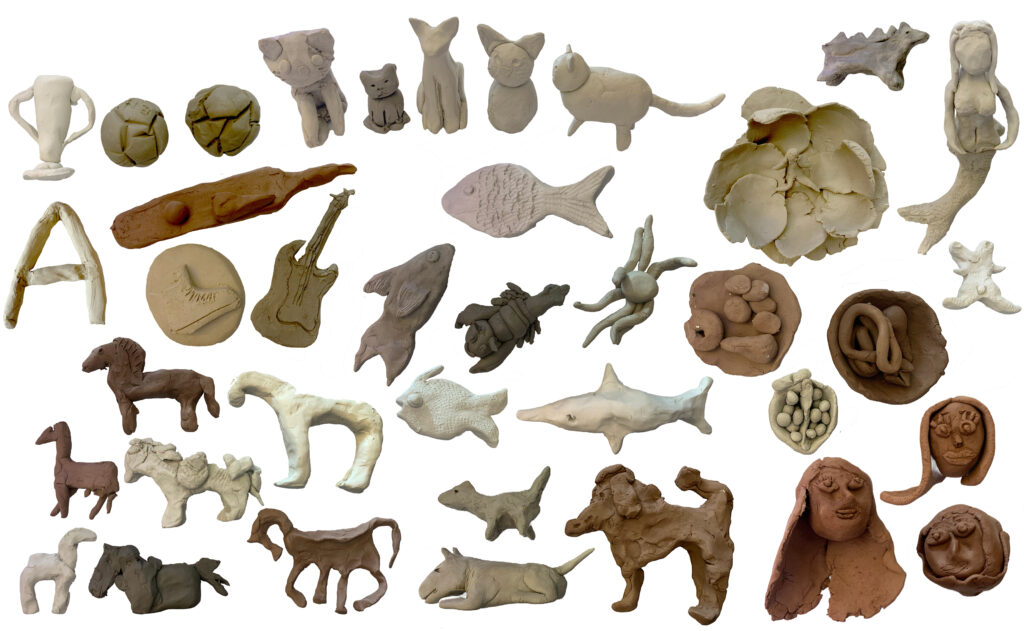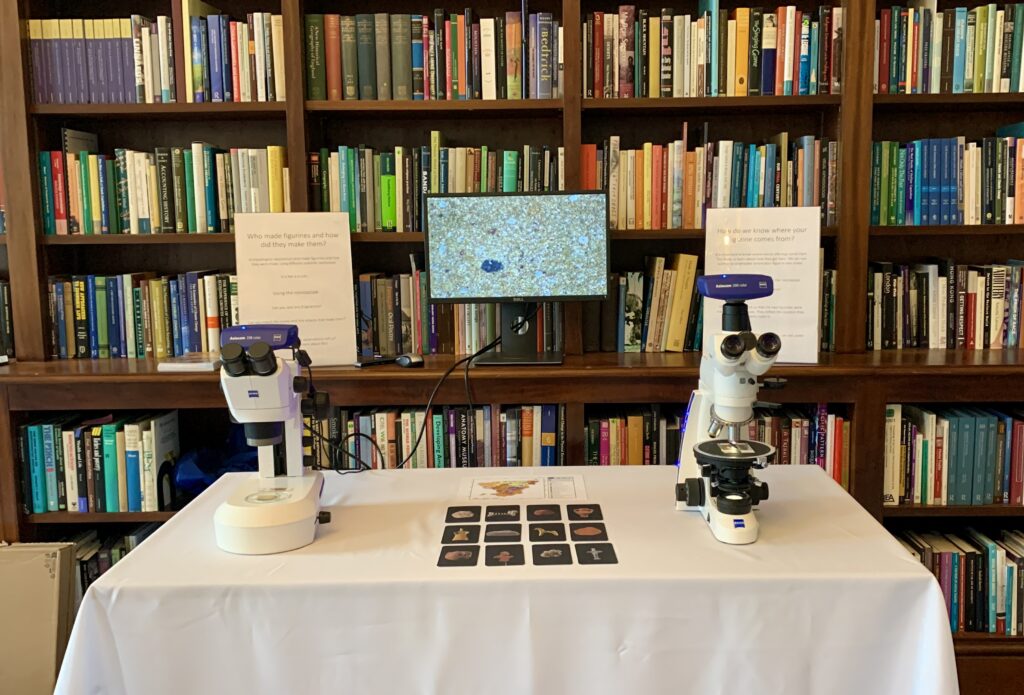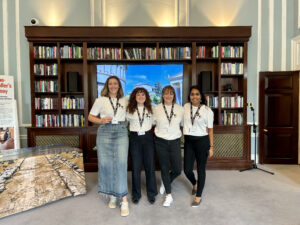From Footballs to Felines! The British Academy Summer Showcase 2024
By Tulsi Parikh and Carlotta Gardner
Ever wondered what it would be like to journey back in time and walk the paths of ancient worshippers? To step into the shoes of someone from thousands of years ago, carrying with you hopes, dreams, and a sacred offering? This was the essence of our interactive exhibit, “Time-Traveller’s Odyssey: Exploring Sacred Journeys through Archaeology and Science,” which we proudly presented at the British Academy Summer Showcase 2024.
A little over a year ago, we embarked on an exciting journey of our own by applying to the showcase, eager to share our interdisciplinary research. To our delight, our proposal was selected, making us one of just eight successful applicants. The real adventure began as we rolled up our sleeves and started preparing for what would become one of the most rewarding experiences of our careers.
A Journey Through Time
The British Academy Summer Showcase, held in July, welcomed approximately 1,500 visitors through its doors. From policymakers and researchers to local school pupils and families, the diverse audience engaged with our exhibit, generating around 700 interactions in our workshop alone. It was really exciting to see such a wide range of people connect with the ancient world through our work.
At the heart of our exhibit lay a simple yet important question: How do we reconstruct people’s journeys in the past? We invited visitors to travel with us to an ancient Greek sanctuary, where they were encouraged to think about the sacred journeys people undertook to worship the gods. Our goal was to make the past tangible, asking participants to create their own votive offerings, dedicate them at a symbolic sanctuary, and explore how modern scientific techniques can reveal the origins of ancient artefacts.
The Hands-On Experience
We transformed the Reading Room of the newly renovated British Academy into a hub of creative activity, setting up three figurine workshops that represented different ancient landscapes: coastal, rural, and roadside. Each workshop featured a different type of clay, symbolising the raw materials used in antiquity, and participants had the opportunity to craft their own figurines. The diversity of the objects created was astounding—from footballs symbolising hopes for a victorious Euro2024 final, to As for good grades, and, of course, a plethora of cats!
 One of the highlights of the exhibit was our symbolic sanctuary – to whom we owe huge thanks to Hallvard Indgjerd, who created a 3D model of a temple for us, and Bonna Wescoat, who allowed us to use Emory’s 3D walkthrough of the sanctuary at Samothrace. This immersive experience brought the ancient Greek sanctuary to life, as visitors placed their handmade offerings in the temple. Over the course of three days, we received at least 300 offerings, and the feedback from participants was overwhelmingly positive—they loved the immersive, hands-on, and therapeutic nature of the exhibit.
One of the highlights of the exhibit was our symbolic sanctuary – to whom we owe huge thanks to Hallvard Indgjerd, who created a 3D model of a temple for us, and Bonna Wescoat, who allowed us to use Emory’s 3D walkthrough of the sanctuary at Samothrace. This immersive experience brought the ancient Greek sanctuary to life, as visitors placed their handmade offerings in the temple. Over the course of three days, we received at least 300 offerings, and the feedback from participants was overwhelmingly positive—they loved the immersive, hands-on, and therapeutic nature of the exhibit.
The Science Behind Ancient Crafts
 In our exhibit’s ‘Science Corner’, we invited visitors to explore the intersection of science and archaeology. Thanks to ZEISS, we had high-quality microscopes and cool new cameras that gave people the opportunity to see live images from the microscopes on their phones, which allowed visitors to see what pottery looks like under the microscope. To most, what they saw was a huge surprise – intricate patterns and vibrant colours that many compared to the works of Gustav Klimt or the shifting images of a kaleidoscope. Combining this with the study of geological maps, visitors were able to understand how we reconstruct where a ceramic artefact was made, and reflect on its journey based on where it was found. This unexpected blend of archaeology and science left a lasting impression, showing how scientific techniques can reveal the beauty and complexity of ancient artefacts in ways that are both informative and visually stunning.
In our exhibit’s ‘Science Corner’, we invited visitors to explore the intersection of science and archaeology. Thanks to ZEISS, we had high-quality microscopes and cool new cameras that gave people the opportunity to see live images from the microscopes on their phones, which allowed visitors to see what pottery looks like under the microscope. To most, what they saw was a huge surprise – intricate patterns and vibrant colours that many compared to the works of Gustav Klimt or the shifting images of a kaleidoscope. Combining this with the study of geological maps, visitors were able to understand how we reconstruct where a ceramic artefact was made, and reflect on its journey based on where it was found. This unexpected blend of archaeology and science left a lasting impression, showing how scientific techniques can reveal the beauty and complexity of ancient artefacts in ways that are both informative and visually stunning.
A Collaborative Triumph
 Our personal highlights include: the school morning, which was filled with interesting conversations, unique questions, and the infectious enthusiasm of bright and diverse young minds; and working with an incredible team, including Rosie Beaumont-Thomas, Cosi Carnegie, Hannah Page, and the fantastic British Academy team.
Our personal highlights include: the school morning, which was filled with interesting conversations, unique questions, and the infectious enthusiasm of bright and diverse young minds; and working with an incredible team, including Rosie Beaumont-Thomas, Cosi Carnegie, Hannah Page, and the fantastic British Academy team.
Looking back, the experience was a powerful reminder of the importance of making archaeology accessible and relevant to a broad audience. We really enjoyed the opportunity to communicate our research in a way that resonated with people of all ages and backgrounds. It reinforced our belief that archaeology needs to be more open and accessible, in turn making it relevant and important to communities today, informing policy, and opening alternate paths into STEM subjects.
Looking Forward
As we reflect on our “Time-Traveller’s Odyssey,” we’re filled with a sense of accomplishment and gratitude. We set out to bring the past to life, and in the process, we connected with so many wonderful people who were just as excited about archaeology as we are. The feedback was overwhelmingly positive—visitors loved the tactile experience of working with clay, the relaxing nature of crafting their own objects, and the intriguing blend of science and archaeology.
This journey may have started over a year ago with an application, but it’s far from over. We’re inspired to continue sharing our passion for the past, reminding people of its relevance, and making it accessible to all. Here’s to more journeys, more discoveries, and more opportunities to explore the ancient world together!
To read more about how we reconstruct where something is from, read our recent British Academy blog post: https://www.thebritishacademy.ac.uk/blog/how-do-archaeologists-know-where-ancient-artefacts-came-from/